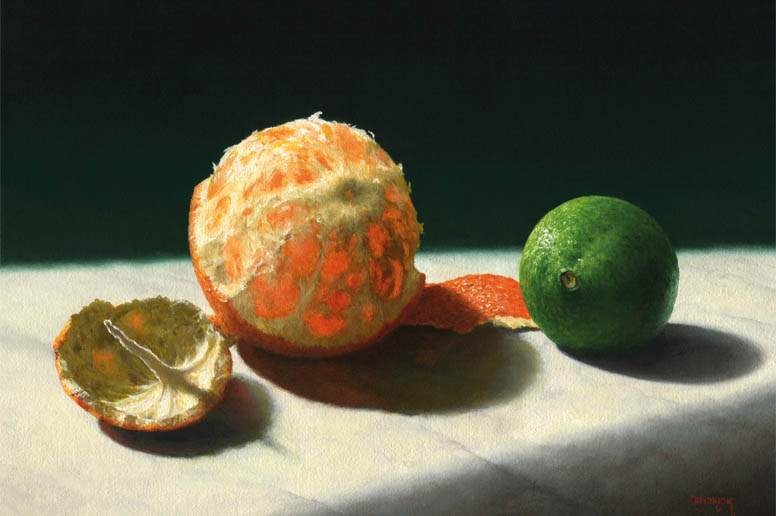A former civil servant, he became a full-time artist in 2003 and exhibits regularly at the Sa ffron Walden Gallery.
He will be showing a selection of new work at the Cambridge City Art Fair this October.
“I used to work in portraiture,” says Chris, “then started to introduce elements of still life into the portraits and found I was increasingly drawn to that. With a still life it’s just me, the canvas and the object, whereas with a model you have to chat to the person to put them at their ease. Plus an orange is easier to find – and it can’t walk away!
“I work in oils and each painting takes about 20-30 hours to complete – spread over about four or six weeks,” he continues. “With each application of paint I have to leave it to dry so I have about nine paintings on the go at any one time. I work a lot with spotlights and try to work from life as much as I can. I’ll start with the original fruit, say a pear, then once it begins to deteriorate I’ll replace it with an approximation in plasticine to give me the shape and shadows of the object. Then right at the end I’ll get in new pears for the colours and textures.”
Using these methods Chris is able to recreate, in exquisite detail, the nature of light reflecting on glass, the texture of a peach or the juicy glow of a peeled, backlit orange.
“It’s a question of analysing the work of the old masters and working out how they achieved those e ffects.”
Chris draws inspiration from 17th century artists such as Diego Velazquez and Dutch master Willem Kalf: a particular favourite. “There’s some of his work in the National Gallery in London and it’s outstanding,” says Chris of Kalf. “One of his paintings is called ‘Still Life with Drinking Horn’ which has this immaculate, wonderful red lobster in the foreground. I could stand in front of it all day.”
On modern art, he says: “I’ve plenty of time for the Rothkos and Damien Hirsts: art is a broad church. It just happens that I tend to see the world in a more figurative way. To me the joy is in the technical challenge of trying to capture things like reflections in a glass or through liquid.”
He adds: “If someone looking at one of my paintings then goes back and looks at things in a slightly di fferent way – what makes a wine glass a wine glass, or why light behaves in such a way – then that’s great. These are things we see every day but don’t necessarily take much notice of. Yet they define the world around us.”

